Project Risk and Procurement Management in Global Food Supply Chain
VerifiedAdded on 2023/04/26
|22
|4743
|426
Report
AI Summary
This report delves into global supply chain management, focusing on Supplier Relationship Management (SRM), strategic procurement, supply chain risk management, and sustainable procurement. It examines the complexities of SRM, where actors aim to maximize profits amidst intense competition, highlighting the need for organizations to foster strong supplier relationships for competitive advantage. Strategic procurement is identified as a key value chain process impacting quality and price, while supply chain risk management action plans are analyzed for their effectiveness in mitigating identified risks. The report also addresses the importance of integrating sustainability into supply chain activities, from raw materials to final product delivery. A case study of a UK-based small business importing from Greece illustrates the application of these concepts, evaluating its SRM, risk management, strategic procurement, and sustainability practices within the context of Brexit.
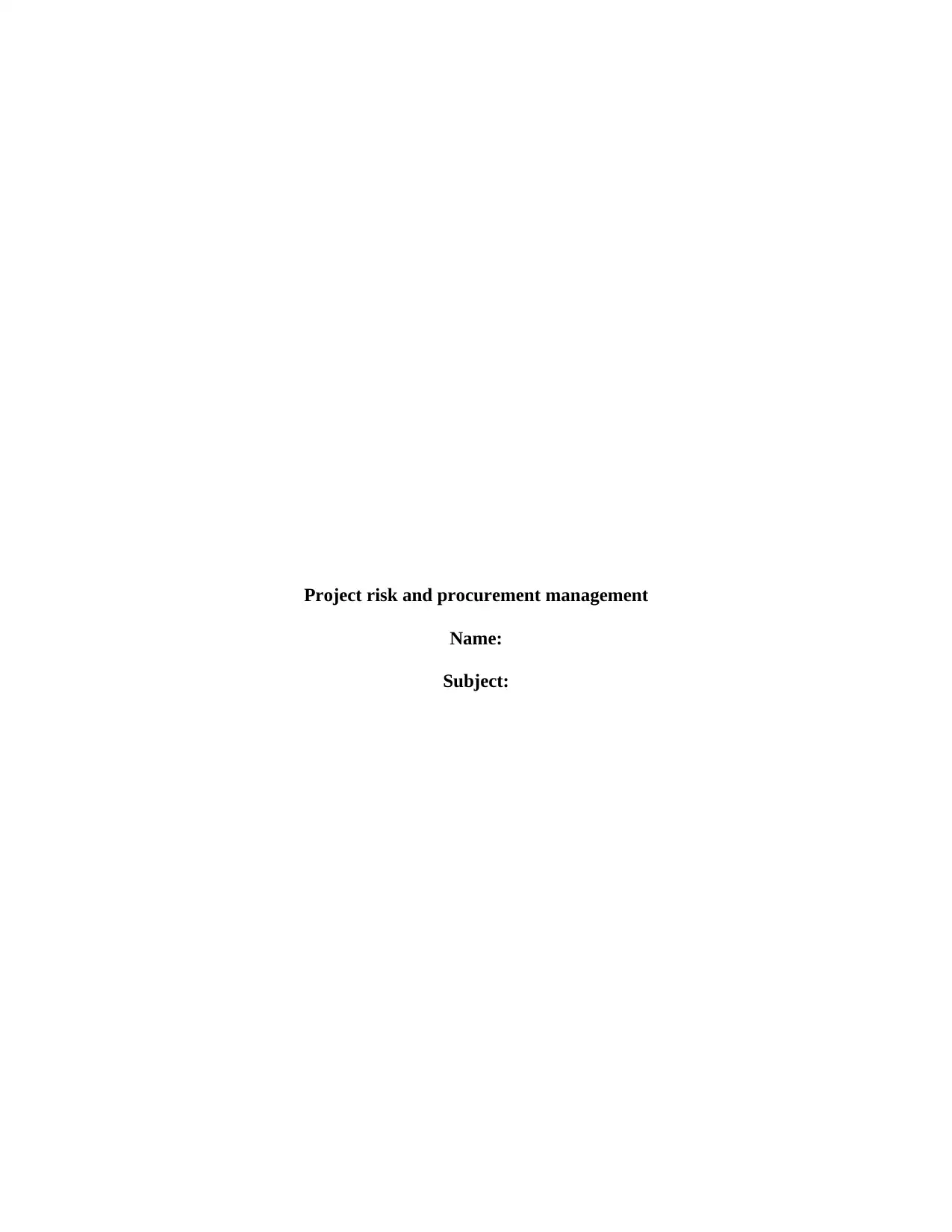
Project risk and procurement management
Name:
Subject:
Name:
Subject:
Paraphrase This Document
Need a fresh take? Get an instant paraphrase of this document with our AI Paraphraser
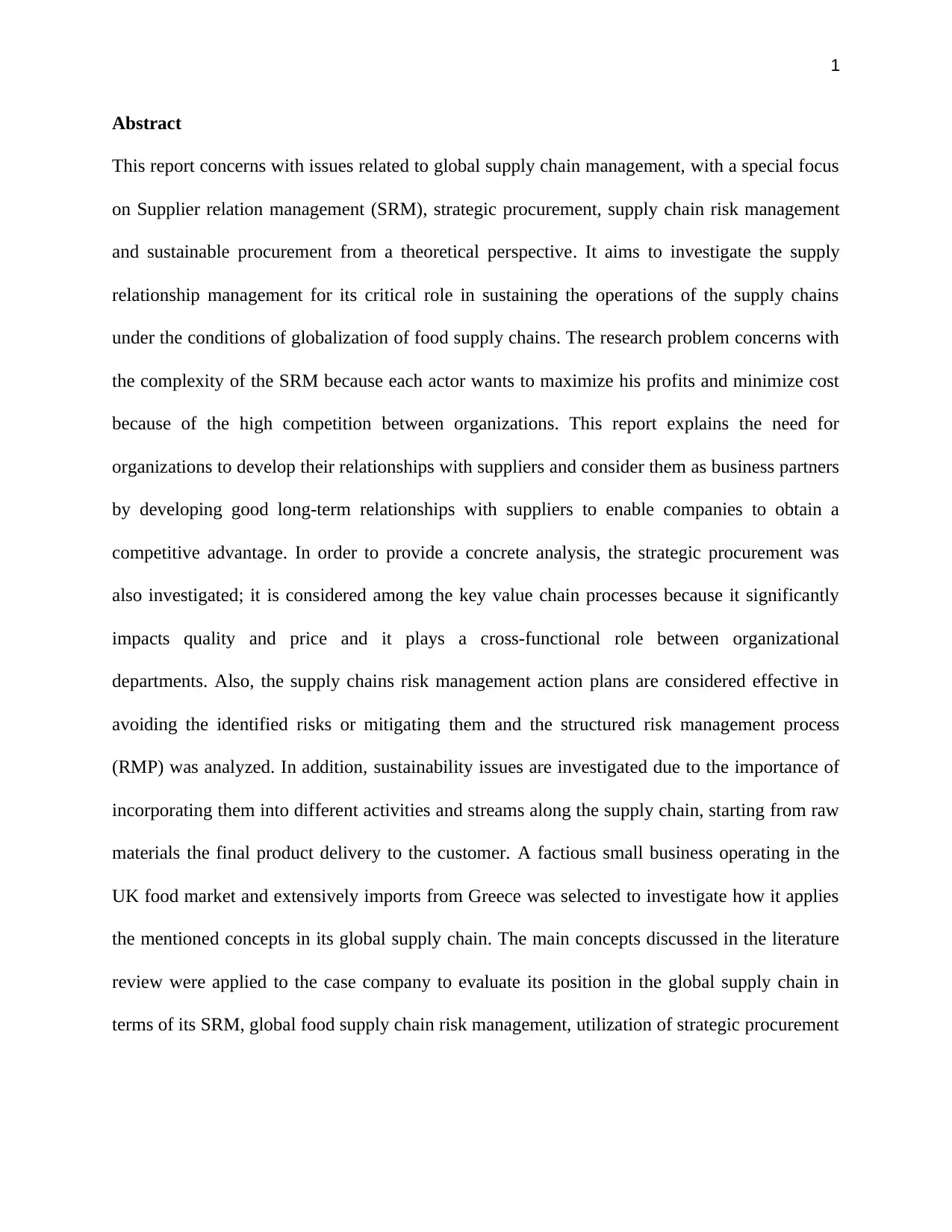
1
Abstract
This report concerns with issues related to global supply chain management, with a special focus
on Supplier relation management (SRM), strategic procurement, supply chain risk management
and sustainable procurement from a theoretical perspective. It aims to investigate the supply
relationship management for its critical role in sustaining the operations of the supply chains
under the conditions of globalization of food supply chains. The research problem concerns with
the complexity of the SRM because each actor wants to maximize his profits and minimize cost
because of the high competition between organizations. This report explains the need for
organizations to develop their relationships with suppliers and consider them as business partners
by developing good long-term relationships with suppliers to enable companies to obtain a
competitive advantage. In order to provide a concrete analysis, the strategic procurement was
also investigated; it is considered among the key value chain processes because it significantly
impacts quality and price and it plays a cross-functional role between organizational
departments. Also, the supply chains risk management action plans are considered effective in
avoiding the identified risks or mitigating them and the structured risk management process
(RMP) was analyzed. In addition, sustainability issues are investigated due to the importance of
incorporating them into different activities and streams along the supply chain, starting from raw
materials the final product delivery to the customer. A factious small business operating in the
UK food market and extensively imports from Greece was selected to investigate how it applies
the mentioned concepts in its global supply chain. The main concepts discussed in the literature
review were applied to the case company to evaluate its position in the global supply chain in
terms of its SRM, global food supply chain risk management, utilization of strategic procurement
Abstract
This report concerns with issues related to global supply chain management, with a special focus
on Supplier relation management (SRM), strategic procurement, supply chain risk management
and sustainable procurement from a theoretical perspective. It aims to investigate the supply
relationship management for its critical role in sustaining the operations of the supply chains
under the conditions of globalization of food supply chains. The research problem concerns with
the complexity of the SRM because each actor wants to maximize his profits and minimize cost
because of the high competition between organizations. This report explains the need for
organizations to develop their relationships with suppliers and consider them as business partners
by developing good long-term relationships with suppliers to enable companies to obtain a
competitive advantage. In order to provide a concrete analysis, the strategic procurement was
also investigated; it is considered among the key value chain processes because it significantly
impacts quality and price and it plays a cross-functional role between organizational
departments. Also, the supply chains risk management action plans are considered effective in
avoiding the identified risks or mitigating them and the structured risk management process
(RMP) was analyzed. In addition, sustainability issues are investigated due to the importance of
incorporating them into different activities and streams along the supply chain, starting from raw
materials the final product delivery to the customer. A factious small business operating in the
UK food market and extensively imports from Greece was selected to investigate how it applies
the mentioned concepts in its global supply chain. The main concepts discussed in the literature
review were applied to the case company to evaluate its position in the global supply chain in
terms of its SRM, global food supply chain risk management, utilization of strategic procurement
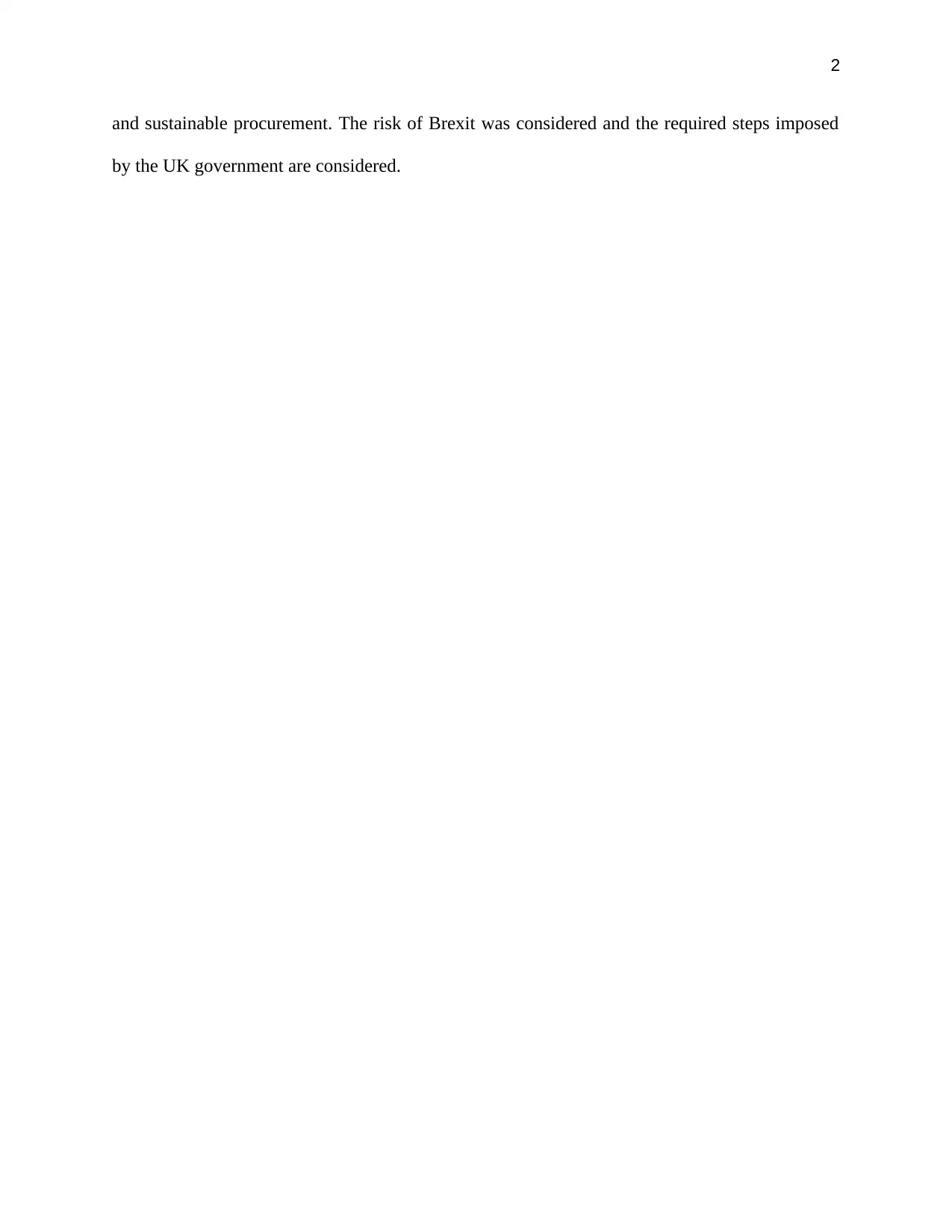
2
and sustainable procurement. The risk of Brexit was considered and the required steps imposed
by the UK government are considered.
and sustainable procurement. The risk of Brexit was considered and the required steps imposed
by the UK government are considered.
⊘ This is a preview!⊘
Do you want full access?
Subscribe today to unlock all pages.

Trusted by 1+ million students worldwide
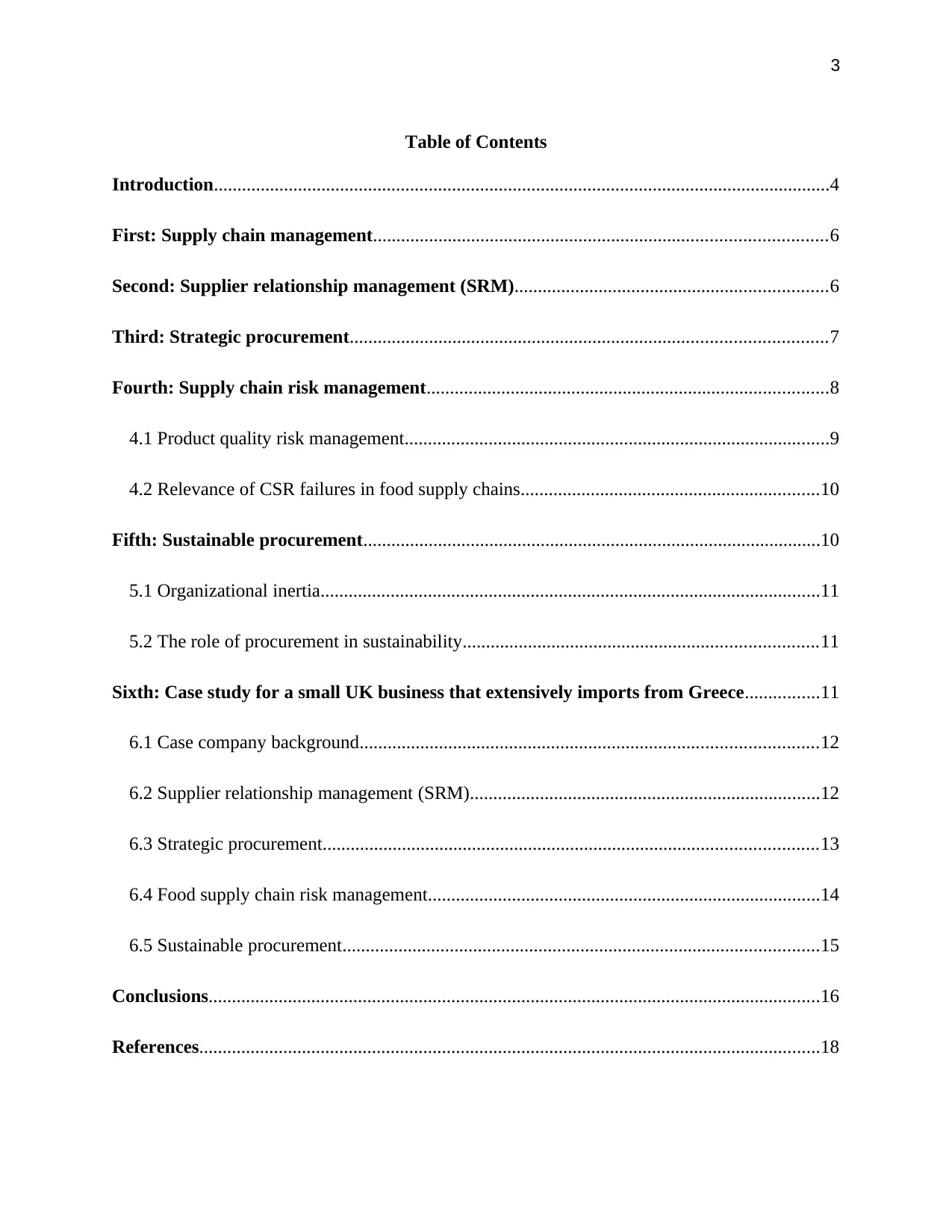
3
Table of Contents
Introduction....................................................................................................................................4
First: Supply chain management.................................................................................................6
Second: Supplier relationship management (SRM)...................................................................6
Third: Strategic procurement......................................................................................................7
Fourth: Supply chain risk management......................................................................................8
4.1 Product quality risk management...........................................................................................9
4.2 Relevance of CSR failures in food supply chains................................................................10
Fifth: Sustainable procurement..................................................................................................10
5.1 Organizational inertia...........................................................................................................11
5.2 The role of procurement in sustainability............................................................................11
Sixth: Case study for a small UK business that extensively imports from Greece................11
6.1 Case company background..................................................................................................12
6.2 Supplier relationship management (SRM)...........................................................................12
6.3 Strategic procurement..........................................................................................................13
6.4 Food supply chain risk management....................................................................................14
6.5 Sustainable procurement......................................................................................................15
Conclusions...................................................................................................................................16
References.....................................................................................................................................18
Table of Contents
Introduction....................................................................................................................................4
First: Supply chain management.................................................................................................6
Second: Supplier relationship management (SRM)...................................................................6
Third: Strategic procurement......................................................................................................7
Fourth: Supply chain risk management......................................................................................8
4.1 Product quality risk management...........................................................................................9
4.2 Relevance of CSR failures in food supply chains................................................................10
Fifth: Sustainable procurement..................................................................................................10
5.1 Organizational inertia...........................................................................................................11
5.2 The role of procurement in sustainability............................................................................11
Sixth: Case study for a small UK business that extensively imports from Greece................11
6.1 Case company background..................................................................................................12
6.2 Supplier relationship management (SRM)...........................................................................12
6.3 Strategic procurement..........................................................................................................13
6.4 Food supply chain risk management....................................................................................14
6.5 Sustainable procurement......................................................................................................15
Conclusions...................................................................................................................................16
References.....................................................................................................................................18
Paraphrase This Document
Need a fresh take? Get an instant paraphrase of this document with our AI Paraphraser
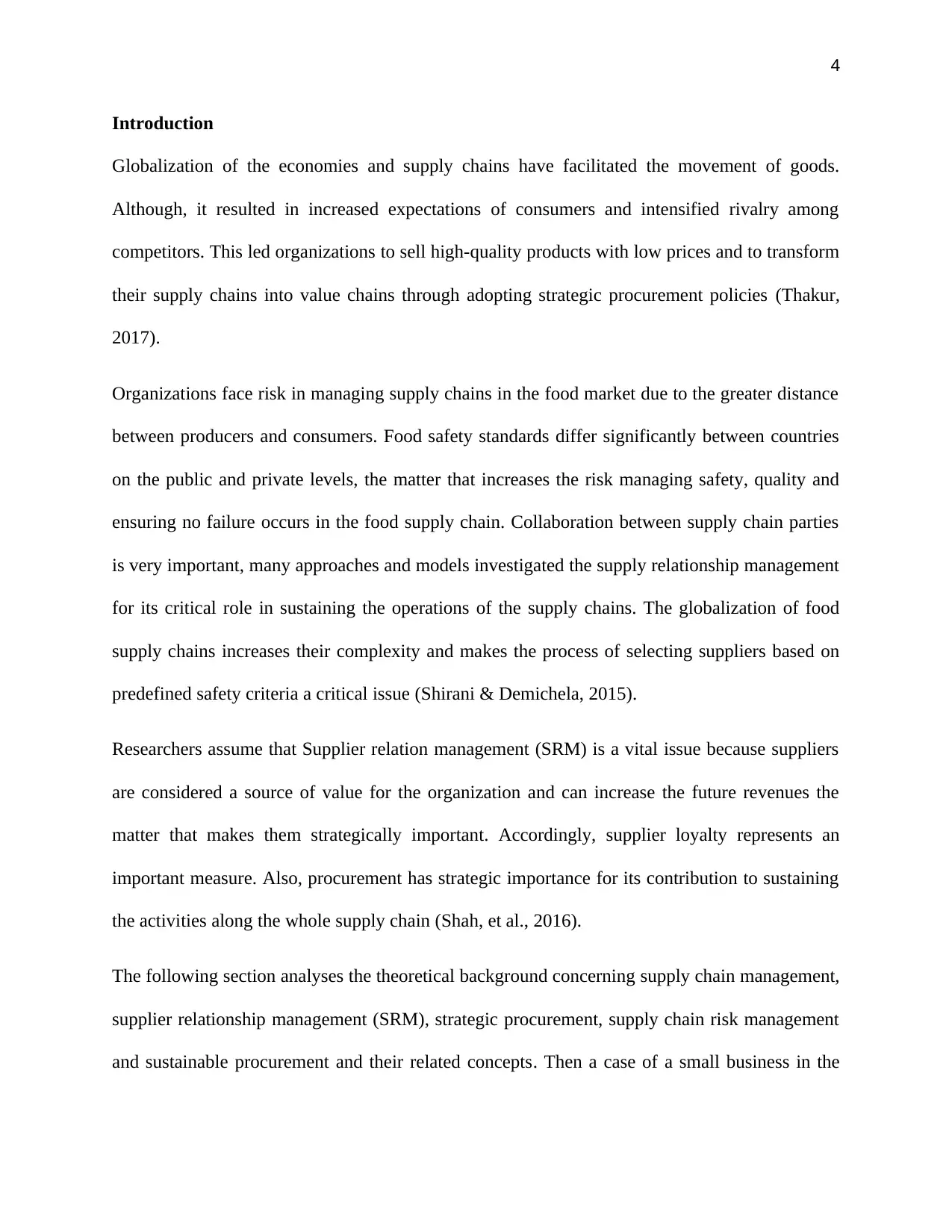
4
Introduction
Globalization of the economies and supply chains have facilitated the movement of goods.
Although, it resulted in increased expectations of consumers and intensified rivalry among
competitors. This led organizations to sell high-quality products with low prices and to transform
their supply chains into value chains through adopting strategic procurement policies (Thakur,
2017).
Organizations face risk in managing supply chains in the food market due to the greater distance
between producers and consumers. Food safety standards differ significantly between countries
on the public and private levels, the matter that increases the risk managing safety, quality and
ensuring no failure occurs in the food supply chain. Collaboration between supply chain parties
is very important, many approaches and models investigated the supply relationship management
for its critical role in sustaining the operations of the supply chains. The globalization of food
supply chains increases their complexity and makes the process of selecting suppliers based on
predefined safety criteria a critical issue (Shirani & Demichela, 2015).
Researchers assume that Supplier relation management (SRM) is a vital issue because suppliers
are considered a source of value for the organization and can increase the future revenues the
matter that makes them strategically important. Accordingly, supplier loyalty represents an
important measure. Also, procurement has strategic importance for its contribution to sustaining
the activities along the whole supply chain (Shah, et al., 2016).
The following section analyses the theoretical background concerning supply chain management,
supplier relationship management (SRM), strategic procurement, supply chain risk management
and sustainable procurement and their related concepts. Then a case of a small business in the
Introduction
Globalization of the economies and supply chains have facilitated the movement of goods.
Although, it resulted in increased expectations of consumers and intensified rivalry among
competitors. This led organizations to sell high-quality products with low prices and to transform
their supply chains into value chains through adopting strategic procurement policies (Thakur,
2017).
Organizations face risk in managing supply chains in the food market due to the greater distance
between producers and consumers. Food safety standards differ significantly between countries
on the public and private levels, the matter that increases the risk managing safety, quality and
ensuring no failure occurs in the food supply chain. Collaboration between supply chain parties
is very important, many approaches and models investigated the supply relationship management
for its critical role in sustaining the operations of the supply chains. The globalization of food
supply chains increases their complexity and makes the process of selecting suppliers based on
predefined safety criteria a critical issue (Shirani & Demichela, 2015).
Researchers assume that Supplier relation management (SRM) is a vital issue because suppliers
are considered a source of value for the organization and can increase the future revenues the
matter that makes them strategically important. Accordingly, supplier loyalty represents an
important measure. Also, procurement has strategic importance for its contribution to sustaining
the activities along the whole supply chain (Shah, et al., 2016).
The following section analyses the theoretical background concerning supply chain management,
supplier relationship management (SRM), strategic procurement, supply chain risk management
and sustainable procurement and their related concepts. Then a case of a small business in the
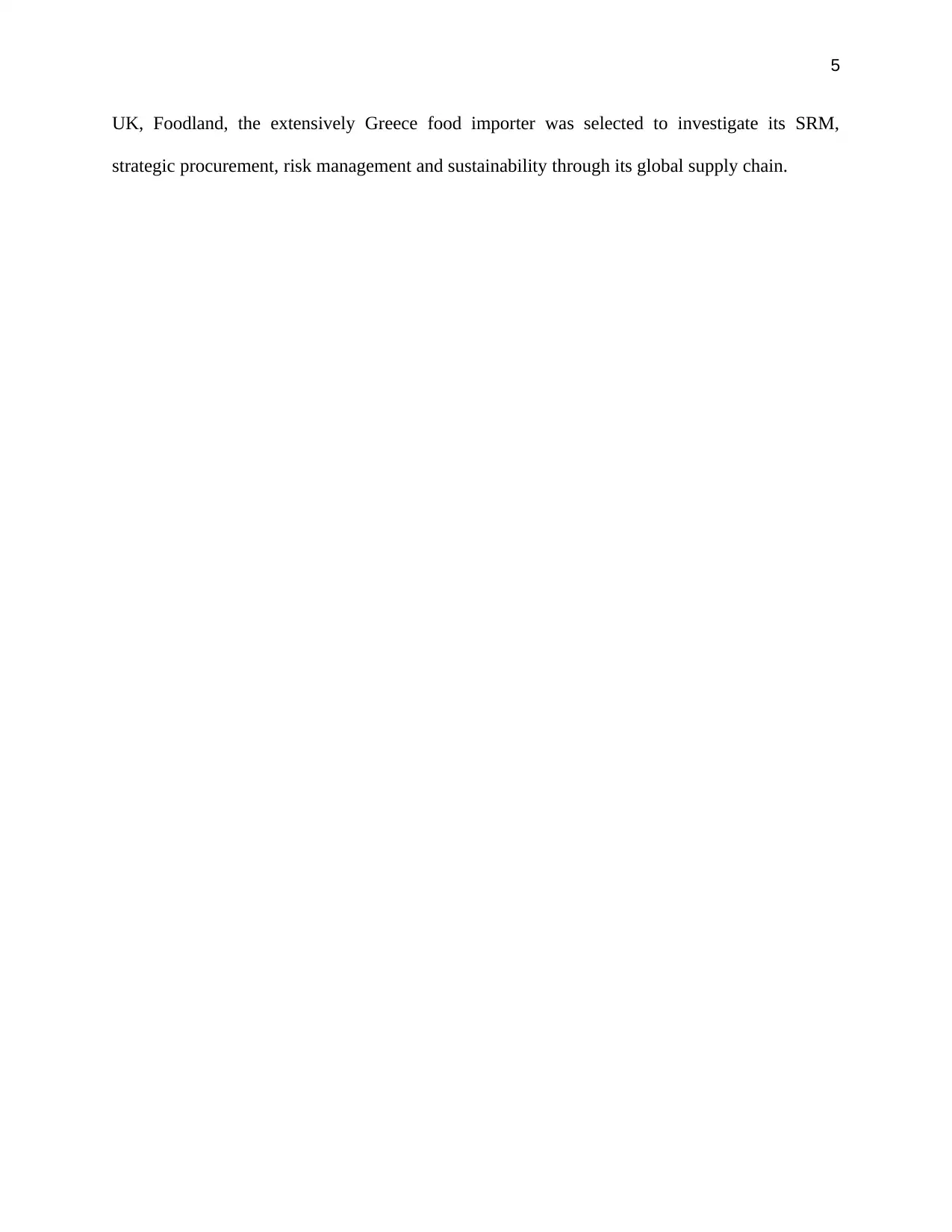
5
UK, Foodland, the extensively Greece food importer was selected to investigate its SRM,
strategic procurement, risk management and sustainability through its global supply chain.
UK, Foodland, the extensively Greece food importer was selected to investigate its SRM,
strategic procurement, risk management and sustainability through its global supply chain.
⊘ This is a preview!⊘
Do you want full access?
Subscribe today to unlock all pages.

Trusted by 1+ million students worldwide
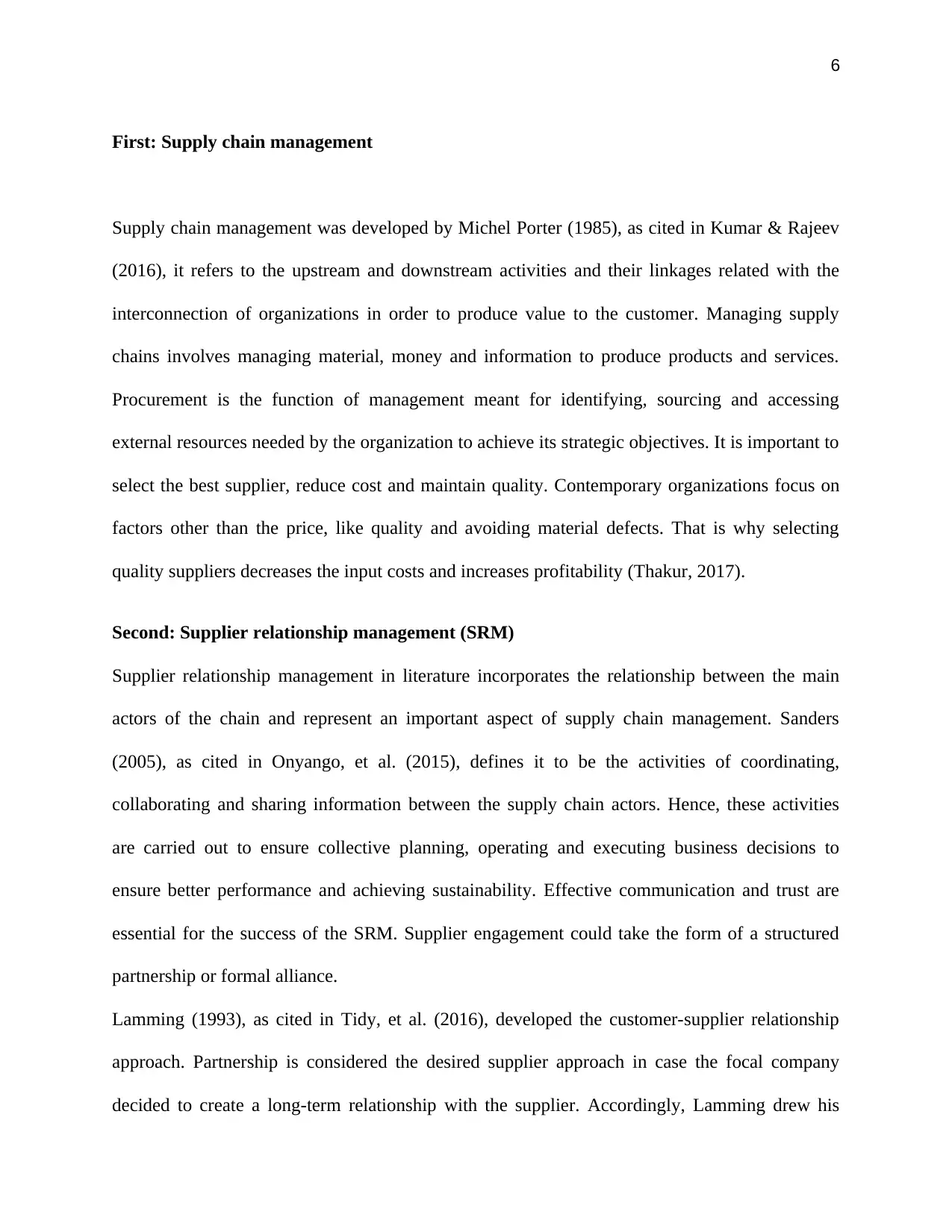
6
First: Supply chain management
Supply chain management was developed by Michel Porter (1985), as cited in Kumar & Rajeev
(2016), it refers to the upstream and downstream activities and their linkages related with the
interconnection of organizations in order to produce value to the customer. Managing supply
chains involves managing material, money and information to produce products and services.
Procurement is the function of management meant for identifying, sourcing and accessing
external resources needed by the organization to achieve its strategic objectives. It is important to
select the best supplier, reduce cost and maintain quality. Contemporary organizations focus on
factors other than the price, like quality and avoiding material defects. That is why selecting
quality suppliers decreases the input costs and increases profitability (Thakur, 2017).
Second: Supplier relationship management (SRM)
Supplier relationship management in literature incorporates the relationship between the main
actors of the chain and represent an important aspect of supply chain management. Sanders
(2005), as cited in Onyango, et al. (2015), defines it to be the activities of coordinating,
collaborating and sharing information between the supply chain actors. Hence, these activities
are carried out to ensure collective planning, operating and executing business decisions to
ensure better performance and achieving sustainability. Effective communication and trust are
essential for the success of the SRM. Supplier engagement could take the form of a structured
partnership or formal alliance.
Lamming (1993), as cited in Tidy, et al. (2016), developed the customer-supplier relationship
approach. Partnership is considered the desired supplier approach in case the focal company
decided to create a long-term relationship with the supplier. Accordingly, Lamming drew his
First: Supply chain management
Supply chain management was developed by Michel Porter (1985), as cited in Kumar & Rajeev
(2016), it refers to the upstream and downstream activities and their linkages related with the
interconnection of organizations in order to produce value to the customer. Managing supply
chains involves managing material, money and information to produce products and services.
Procurement is the function of management meant for identifying, sourcing and accessing
external resources needed by the organization to achieve its strategic objectives. It is important to
select the best supplier, reduce cost and maintain quality. Contemporary organizations focus on
factors other than the price, like quality and avoiding material defects. That is why selecting
quality suppliers decreases the input costs and increases profitability (Thakur, 2017).
Second: Supplier relationship management (SRM)
Supplier relationship management in literature incorporates the relationship between the main
actors of the chain and represent an important aspect of supply chain management. Sanders
(2005), as cited in Onyango, et al. (2015), defines it to be the activities of coordinating,
collaborating and sharing information between the supply chain actors. Hence, these activities
are carried out to ensure collective planning, operating and executing business decisions to
ensure better performance and achieving sustainability. Effective communication and trust are
essential for the success of the SRM. Supplier engagement could take the form of a structured
partnership or formal alliance.
Lamming (1993), as cited in Tidy, et al. (2016), developed the customer-supplier relationship
approach. Partnership is considered the desired supplier approach in case the focal company
decided to create a long-term relationship with the supplier. Accordingly, Lamming drew his
Paraphrase This Document
Need a fresh take? Get an instant paraphrase of this document with our AI Paraphraser
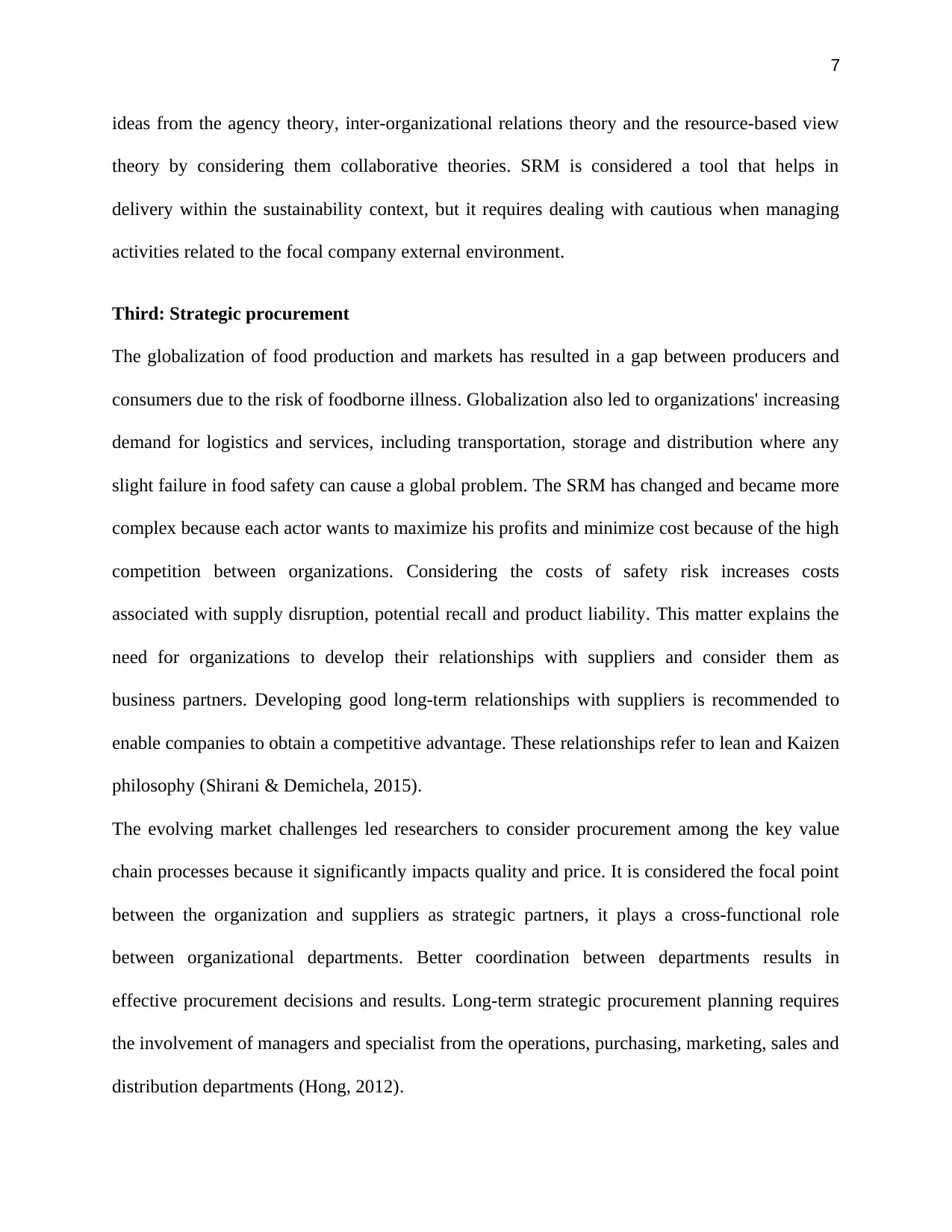
7
ideas from the agency theory, inter-organizational relations theory and the resource-based view
theory by considering them collaborative theories. SRM is considered a tool that helps in
delivery within the sustainability context, but it requires dealing with cautious when managing
activities related to the focal company external environment.
Third: Strategic procurement
The globalization of food production and markets has resulted in a gap between producers and
consumers due to the risk of foodborne illness. Globalization also led to organizations' increasing
demand for logistics and services, including transportation, storage and distribution where any
slight failure in food safety can cause a global problem. The SRM has changed and became more
complex because each actor wants to maximize his profits and minimize cost because of the high
competition between organizations. Considering the costs of safety risk increases costs
associated with supply disruption, potential recall and product liability. This matter explains the
need for organizations to develop their relationships with suppliers and consider them as
business partners. Developing good long-term relationships with suppliers is recommended to
enable companies to obtain a competitive advantage. These relationships refer to lean and Kaizen
philosophy (Shirani & Demichela, 2015).
The evolving market challenges led researchers to consider procurement among the key value
chain processes because it significantly impacts quality and price. It is considered the focal point
between the organization and suppliers as strategic partners, it plays a cross-functional role
between organizational departments. Better coordination between departments results in
effective procurement decisions and results. Long-term strategic procurement planning requires
the involvement of managers and specialist from the operations, purchasing, marketing, sales and
distribution departments (Hong, 2012).
ideas from the agency theory, inter-organizational relations theory and the resource-based view
theory by considering them collaborative theories. SRM is considered a tool that helps in
delivery within the sustainability context, but it requires dealing with cautious when managing
activities related to the focal company external environment.
Third: Strategic procurement
The globalization of food production and markets has resulted in a gap between producers and
consumers due to the risk of foodborne illness. Globalization also led to organizations' increasing
demand for logistics and services, including transportation, storage and distribution where any
slight failure in food safety can cause a global problem. The SRM has changed and became more
complex because each actor wants to maximize his profits and minimize cost because of the high
competition between organizations. Considering the costs of safety risk increases costs
associated with supply disruption, potential recall and product liability. This matter explains the
need for organizations to develop their relationships with suppliers and consider them as
business partners. Developing good long-term relationships with suppliers is recommended to
enable companies to obtain a competitive advantage. These relationships refer to lean and Kaizen
philosophy (Shirani & Demichela, 2015).
The evolving market challenges led researchers to consider procurement among the key value
chain processes because it significantly impacts quality and price. It is considered the focal point
between the organization and suppliers as strategic partners, it plays a cross-functional role
between organizational departments. Better coordination between departments results in
effective procurement decisions and results. Long-term strategic procurement planning requires
the involvement of managers and specialist from the operations, purchasing, marketing, sales and
distribution departments (Hong, 2012).
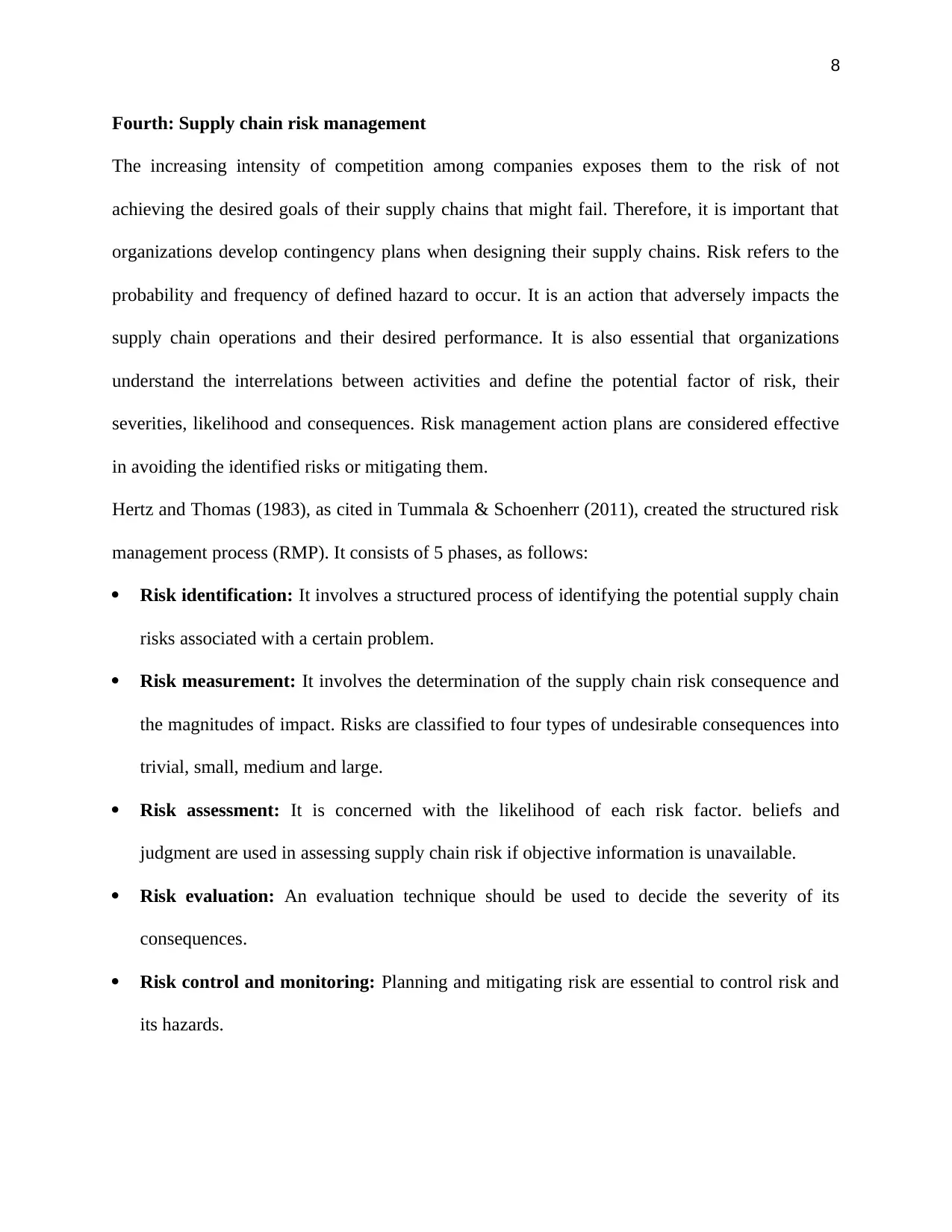
8
Fourth: Supply chain risk management
The increasing intensity of competition among companies exposes them to the risk of not
achieving the desired goals of their supply chains that might fail. Therefore, it is important that
organizations develop contingency plans when designing their supply chains. Risk refers to the
probability and frequency of defined hazard to occur. It is an action that adversely impacts the
supply chain operations and their desired performance. It is also essential that organizations
understand the interrelations between activities and define the potential factor of risk, their
severities, likelihood and consequences. Risk management action plans are considered effective
in avoiding the identified risks or mitigating them.
Hertz and Thomas (1983), as cited in Tummala & Schoenherr (2011), created the structured risk
management process (RMP). It consists of 5 phases, as follows:
Risk identification: It involves a structured process of identifying the potential supply chain
risks associated with a certain problem.
Risk measurement: It involves the determination of the supply chain risk consequence and
the magnitudes of impact. Risks are classified to four types of undesirable consequences into
trivial, small, medium and large.
Risk assessment: It is concerned with the likelihood of each risk factor. beliefs and
judgment are used in assessing supply chain risk if objective information is unavailable.
Risk evaluation: An evaluation technique should be used to decide the severity of its
consequences.
Risk control and monitoring: Planning and mitigating risk are essential to control risk and
its hazards.
Fourth: Supply chain risk management
The increasing intensity of competition among companies exposes them to the risk of not
achieving the desired goals of their supply chains that might fail. Therefore, it is important that
organizations develop contingency plans when designing their supply chains. Risk refers to the
probability and frequency of defined hazard to occur. It is an action that adversely impacts the
supply chain operations and their desired performance. It is also essential that organizations
understand the interrelations between activities and define the potential factor of risk, their
severities, likelihood and consequences. Risk management action plans are considered effective
in avoiding the identified risks or mitigating them.
Hertz and Thomas (1983), as cited in Tummala & Schoenherr (2011), created the structured risk
management process (RMP). It consists of 5 phases, as follows:
Risk identification: It involves a structured process of identifying the potential supply chain
risks associated with a certain problem.
Risk measurement: It involves the determination of the supply chain risk consequence and
the magnitudes of impact. Risks are classified to four types of undesirable consequences into
trivial, small, medium and large.
Risk assessment: It is concerned with the likelihood of each risk factor. beliefs and
judgment are used in assessing supply chain risk if objective information is unavailable.
Risk evaluation: An evaluation technique should be used to decide the severity of its
consequences.
Risk control and monitoring: Planning and mitigating risk are essential to control risk and
its hazards.
⊘ This is a preview!⊘
Do you want full access?
Subscribe today to unlock all pages.

Trusted by 1+ million students worldwide
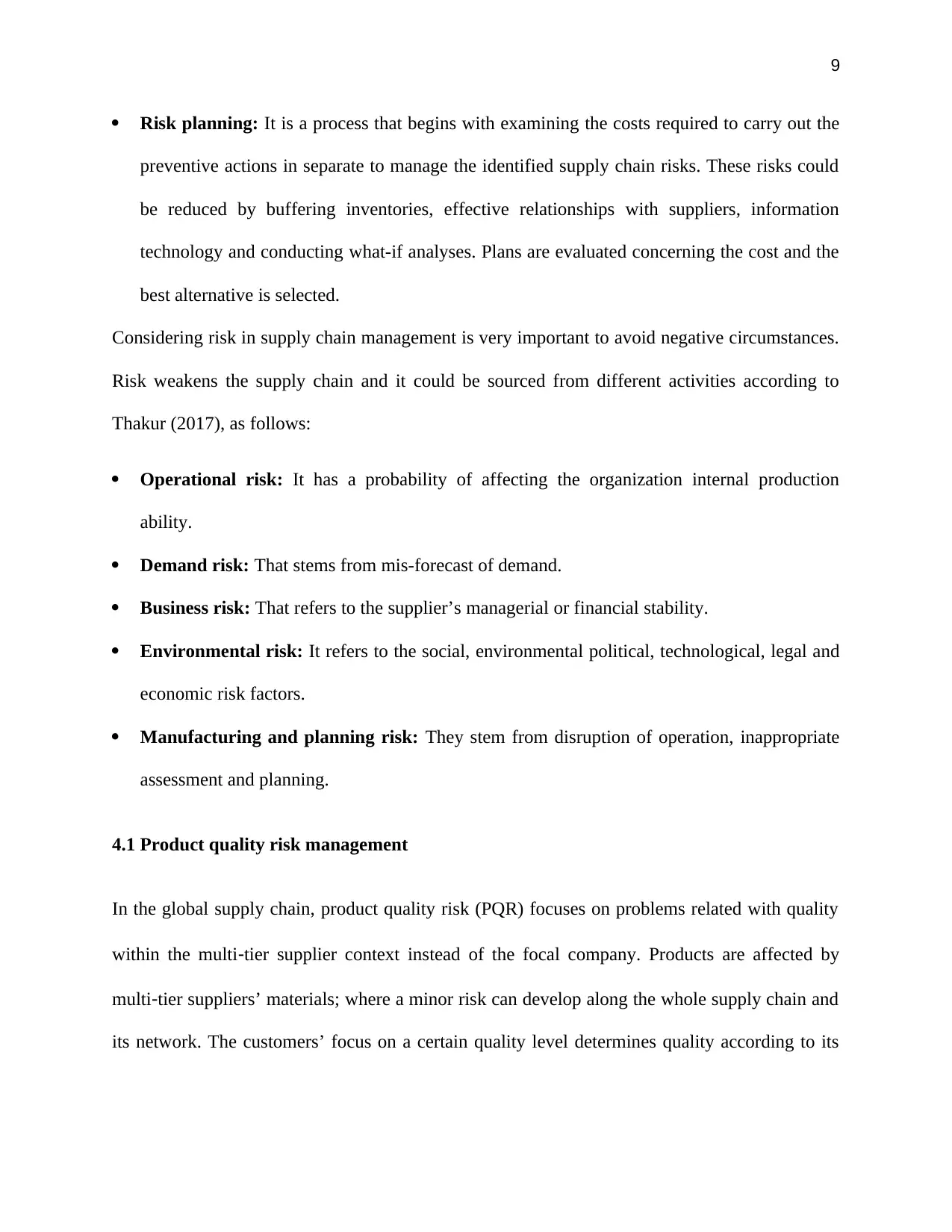
9
Risk planning: It is a process that begins with examining the costs required to carry out the
preventive actions in separate to manage the identified supply chain risks. These risks could
be reduced by buffering inventories, effective relationships with suppliers, information
technology and conducting what-if analyses. Plans are evaluated concerning the cost and the
best alternative is selected.
Considering risk in supply chain management is very important to avoid negative circumstances.
Risk weakens the supply chain and it could be sourced from different activities according to
Thakur (2017), as follows:
Operational risk: It has a probability of affecting the organization internal production
ability.
Demand risk: That stems from mis-forecast of demand.
Business risk: That refers to the supplier’s managerial or financial stability.
Environmental risk: It refers to the social, environmental political, technological, legal and
economic risk factors.
Manufacturing and planning risk: They stem from disruption of operation, inappropriate
assessment and planning.
4.1 Product quality risk management
In the global supply chain, product quality risk (PQR) focuses on problems related with quality
within the multi‐tier supplier context instead of the focal company. Products are affected by
multi‐tier suppliers’ materials; where a minor risk can develop along the whole supply chain and
its network. The customers’ focus on a certain quality level determines quality according to its
Risk planning: It is a process that begins with examining the costs required to carry out the
preventive actions in separate to manage the identified supply chain risks. These risks could
be reduced by buffering inventories, effective relationships with suppliers, information
technology and conducting what-if analyses. Plans are evaluated concerning the cost and the
best alternative is selected.
Considering risk in supply chain management is very important to avoid negative circumstances.
Risk weakens the supply chain and it could be sourced from different activities according to
Thakur (2017), as follows:
Operational risk: It has a probability of affecting the organization internal production
ability.
Demand risk: That stems from mis-forecast of demand.
Business risk: That refers to the supplier’s managerial or financial stability.
Environmental risk: It refers to the social, environmental political, technological, legal and
economic risk factors.
Manufacturing and planning risk: They stem from disruption of operation, inappropriate
assessment and planning.
4.1 Product quality risk management
In the global supply chain, product quality risk (PQR) focuses on problems related with quality
within the multi‐tier supplier context instead of the focal company. Products are affected by
multi‐tier suppliers’ materials; where a minor risk can develop along the whole supply chain and
its network. The customers’ focus on a certain quality level determines quality according to its
Paraphrase This Document
Need a fresh take? Get an instant paraphrase of this document with our AI Paraphraser
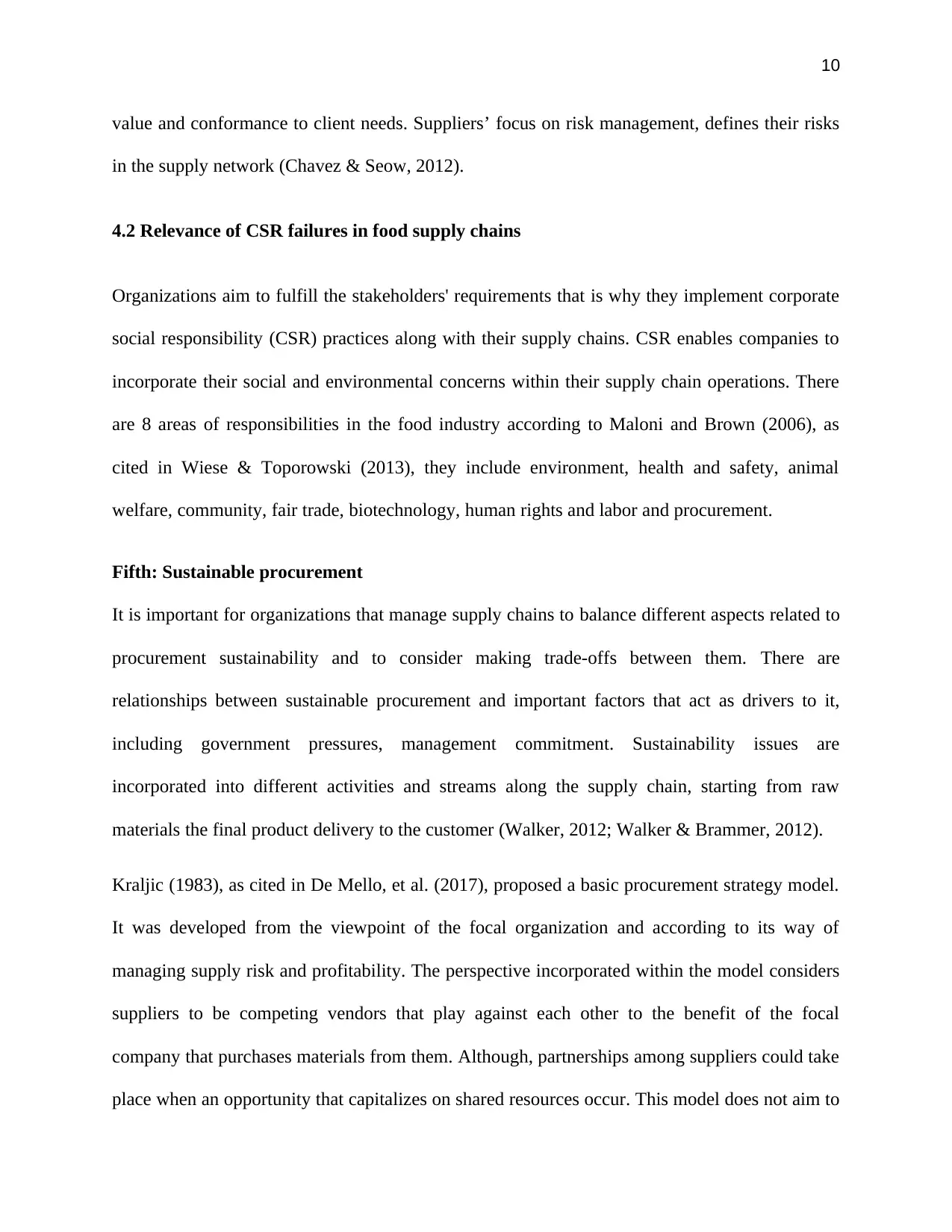
10
value and conformance to client needs. Suppliers’ focus on risk management, defines their risks
in the supply network (Chavez & Seow, 2012).
4.2 Relevance of CSR failures in food supply chains
Organizations aim to fulfill the stakeholders' requirements that is why they implement corporate
social responsibility (CSR) practices along with their supply chains. CSR enables companies to
incorporate their social and environmental concerns within their supply chain operations. There
are 8 areas of responsibilities in the food industry according to Maloni and Brown (2006), as
cited in Wiese & Toporowski (2013), they include environment, health and safety, animal
welfare, community, fair trade, biotechnology, human rights and labor and procurement.
Fifth: Sustainable procurement
It is important for organizations that manage supply chains to balance different aspects related to
procurement sustainability and to consider making trade-offs between them. There are
relationships between sustainable procurement and important factors that act as drivers to it,
including government pressures, management commitment. Sustainability issues are
incorporated into different activities and streams along the supply chain, starting from raw
materials the final product delivery to the customer (Walker, 2012; Walker & Brammer, 2012).
Kraljic (1983), as cited in De Mello, et al. (2017), proposed a basic procurement strategy model.
It was developed from the viewpoint of the focal organization and according to its way of
managing supply risk and profitability. The perspective incorporated within the model considers
suppliers to be competing vendors that play against each other to the benefit of the focal
company that purchases materials from them. Although, partnerships among suppliers could take
place when an opportunity that capitalizes on shared resources occur. This model does not aim to
value and conformance to client needs. Suppliers’ focus on risk management, defines their risks
in the supply network (Chavez & Seow, 2012).
4.2 Relevance of CSR failures in food supply chains
Organizations aim to fulfill the stakeholders' requirements that is why they implement corporate
social responsibility (CSR) practices along with their supply chains. CSR enables companies to
incorporate their social and environmental concerns within their supply chain operations. There
are 8 areas of responsibilities in the food industry according to Maloni and Brown (2006), as
cited in Wiese & Toporowski (2013), they include environment, health and safety, animal
welfare, community, fair trade, biotechnology, human rights and labor and procurement.
Fifth: Sustainable procurement
It is important for organizations that manage supply chains to balance different aspects related to
procurement sustainability and to consider making trade-offs between them. There are
relationships between sustainable procurement and important factors that act as drivers to it,
including government pressures, management commitment. Sustainability issues are
incorporated into different activities and streams along the supply chain, starting from raw
materials the final product delivery to the customer (Walker, 2012; Walker & Brammer, 2012).
Kraljic (1983), as cited in De Mello, et al. (2017), proposed a basic procurement strategy model.
It was developed from the viewpoint of the focal organization and according to its way of
managing supply risk and profitability. The perspective incorporated within the model considers
suppliers to be competing vendors that play against each other to the benefit of the focal
company that purchases materials from them. Although, partnerships among suppliers could take
place when an opportunity that capitalizes on shared resources occur. This model does not aim to
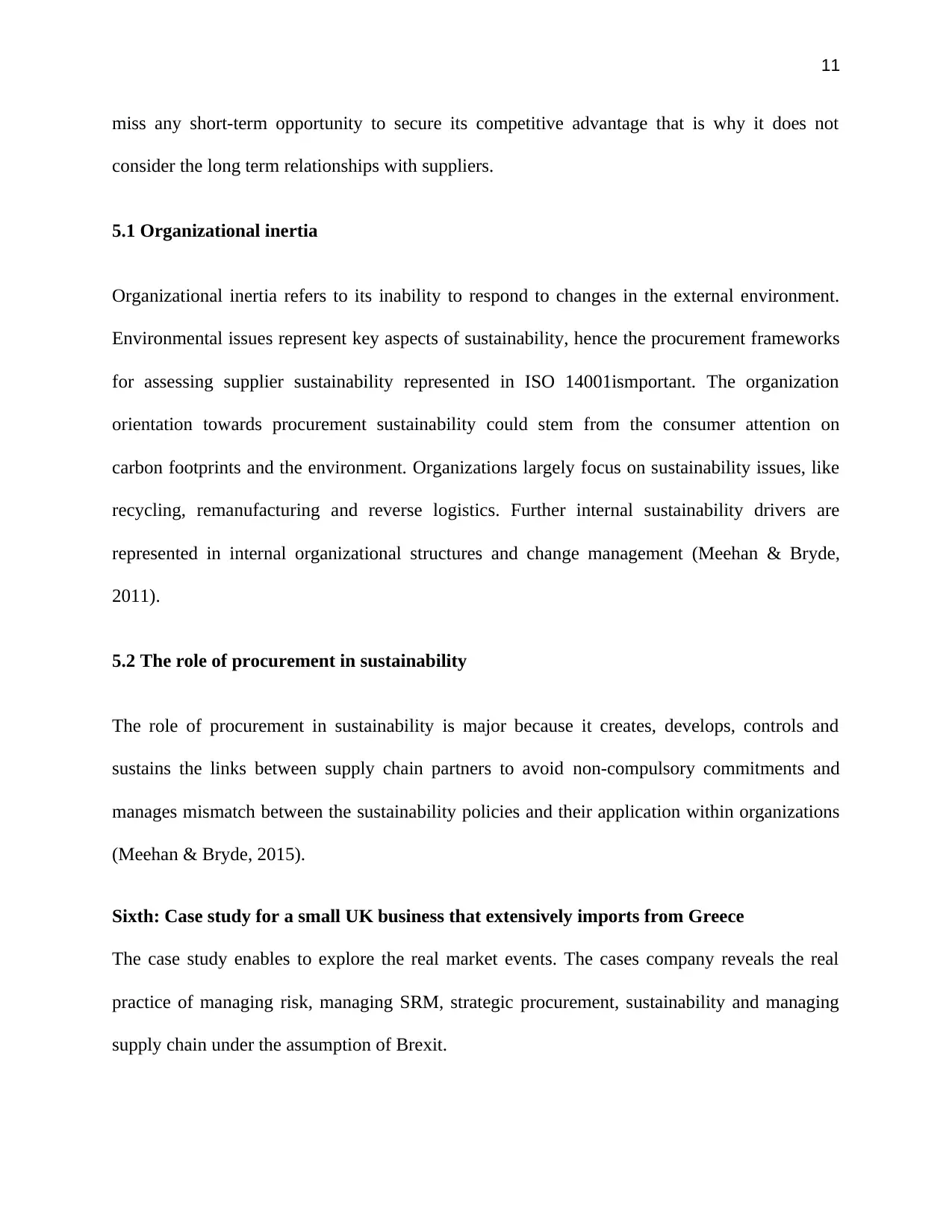
11
miss any short-term opportunity to secure its competitive advantage that is why it does not
consider the long term relationships with suppliers.
5.1 Organizational inertia
Organizational inertia refers to its inability to respond to changes in the external environment.
Environmental issues represent key aspects of sustainability, hence the procurement frameworks
for assessing supplier sustainability represented in ISO 14001ismportant. The organization
orientation towards procurement sustainability could stem from the consumer attention on
carbon footprints and the environment. Organizations largely focus on sustainability issues, like
recycling, remanufacturing and reverse logistics. Further internal sustainability drivers are
represented in internal organizational structures and change management (Meehan & Bryde,
2011).
5.2 The role of procurement in sustainability
The role of procurement in sustainability is major because it creates, develops, controls and
sustains the links between supply chain partners to avoid non-compulsory commitments and
manages mismatch between the sustainability policies and their application within organizations
(Meehan & Bryde, 2015).
Sixth: Case study for a small UK business that extensively imports from Greece
The case study enables to explore the real market events. The cases company reveals the real
practice of managing risk, managing SRM, strategic procurement, sustainability and managing
supply chain under the assumption of Brexit.
miss any short-term opportunity to secure its competitive advantage that is why it does not
consider the long term relationships with suppliers.
5.1 Organizational inertia
Organizational inertia refers to its inability to respond to changes in the external environment.
Environmental issues represent key aspects of sustainability, hence the procurement frameworks
for assessing supplier sustainability represented in ISO 14001ismportant. The organization
orientation towards procurement sustainability could stem from the consumer attention on
carbon footprints and the environment. Organizations largely focus on sustainability issues, like
recycling, remanufacturing and reverse logistics. Further internal sustainability drivers are
represented in internal organizational structures and change management (Meehan & Bryde,
2011).
5.2 The role of procurement in sustainability
The role of procurement in sustainability is major because it creates, develops, controls and
sustains the links between supply chain partners to avoid non-compulsory commitments and
manages mismatch between the sustainability policies and their application within organizations
(Meehan & Bryde, 2015).
Sixth: Case study for a small UK business that extensively imports from Greece
The case study enables to explore the real market events. The cases company reveals the real
practice of managing risk, managing SRM, strategic procurement, sustainability and managing
supply chain under the assumption of Brexit.
⊘ This is a preview!⊘
Do you want full access?
Subscribe today to unlock all pages.

Trusted by 1+ million students worldwide
1 out of 22
Related Documents
Your All-in-One AI-Powered Toolkit for Academic Success.
+13062052269
info@desklib.com
Available 24*7 on WhatsApp / Email
![[object Object]](/_next/static/media/star-bottom.7253800d.svg)
Unlock your academic potential
Copyright © 2020–2025 A2Z Services. All Rights Reserved. Developed and managed by ZUCOL.





